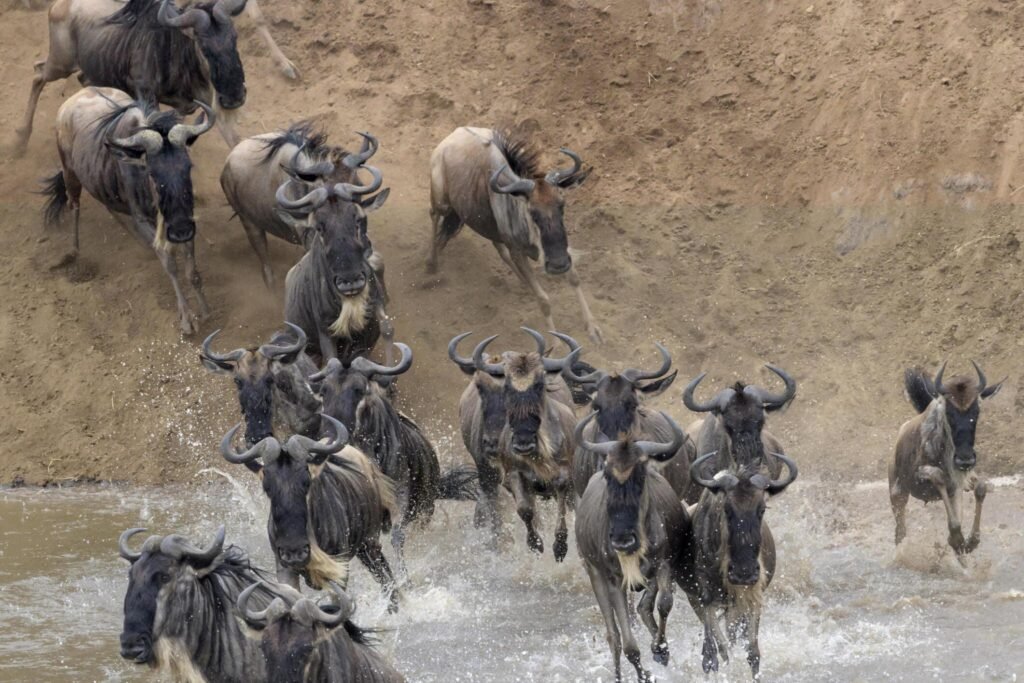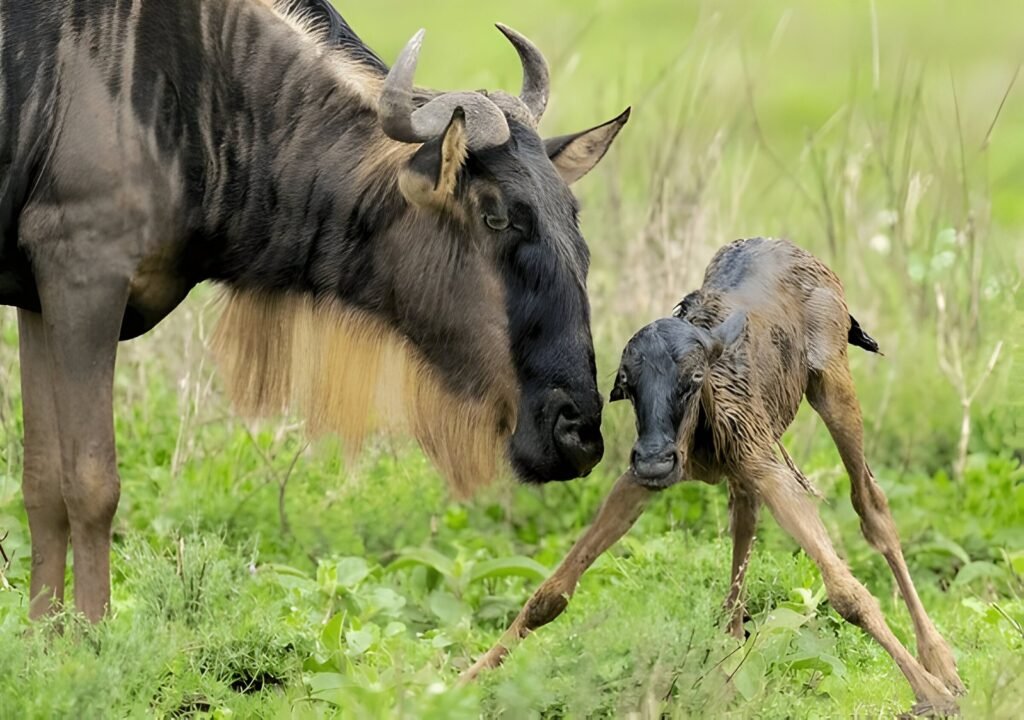This 7-days greatest Serengeti migration safari Mara River crossing for the Mara River crossing is the best, most unique, classic, and one of the most iconic African natural spectacles in the world where the wildebeests gather along the banks of the Mara River waiting for the right moment to cross.

This 7 days Serengeti migration safari for the Mara River crossing is a continuous movement of over 2.7 million wildebeests, zebras, and gazelles across the vast plains of Tanzania and Kenya in search of fresh pasture and water which usually occurs between July and September. Best 7 days Serengeti wildebeest migration safari prices in Tanzania
Book the best 7-days wildebeest migration safari at an affordable prices
Serengeti safari operator will be more than happy to assist you with all the information you need concerning best 7 days Serengeti wildebeest migration safari tours in 2024, 2025, and 2026. The best 7 days 6 nights Serengeti migration safari full itinerary

The full detailed itinerary for the best 7-day Serengeti migration safari in Tanzania:
Day 1: From Arusha to Lake Manyara, 1 hr 52 min (114.1 km); 7-days greatest Serengeti migration safari Mara River crossing
Day 2: From Mto wa Mbu or Karatu to Serengeti, 5 hrs 12 min (269.6 km); 7-days greatest Serengeti migration safari Mara River crossing
Day 3: Full day game drive in Serengeti; Day 4: Central Serengeti – Northern Serengeti (Kogatende Area); 7-days greatest Serengeti migration safari Mara River crossing
Day 5: Northern Serengeti (Kogatende) – Central Serengeti; 7-days greatest Serengeti migration safari Mara River crossing
Day 6: Central Serengeti to Ngorongoro Crater, 4 hrs 25 min (227.7 km); 7-days greatest Serengeti migration safari Mara River crossing
Day 7: Full game drive in Ngorongoro Crater and back to Arusha, 2 hrs 42 min (154.6 km). 7-days greatest Serengeti migration safari Mara River crossing
Day 1: From Arusha to Manyara
You leave Arusha and go to Lake Manyara National Park on the first day of your 7 days Masai Mara wildebeest migration tour.
To finish any last-minute personal shopping, you can make a stop at a supermarket before continuing your two-hour drive to Lake Manyara. At the park’s entrance, your driver will take care of the paperwork before you start your first game drive. One of Tanzania’s smaller parks, Lake Manyara, nonetheless provides an enjoyable and varied safari experience. Elephants, hippos, giraffes, buffaloes, and antelopes can be found in surprising numbers, and the magnificent rocks of the Rift Valley escarpment provide a dramatic backdrop.
After the game drive, we spend the night at Manyara or Karatu.
Day 2: From Manyara or Karatu to Serengeti
The following morning, after breakfast, we depart Manyara (Mto wa mbu) and proceed to the Serengeti National Park via the floor of the Great Rift Valley, an escarpment, and the Ngorongoro Conservation Area. In the end, this will prove to be a pleasant and pleasurable scenic journey as you take in the spectacular scenery and stunning surroundings.
We’ll travel to the Seronera region’s neighbor, the Lobo region (central Serengeti National Park).Then in late October or early November, on its journey to Kenya’s Masai Mara Game Reserve, and once again around July or August, on its way to the southern Serengeti National Park, the wildebeest migration frequently passes through the Lobo region twice a year.
Day 3: Game drive in Serengeti (Seronera Area)
After breakfast on the third day of our seven-day Tanzanian excursion to the northern Serengeti and the Mara River, we have a full-day game drive in the park. All year long, there is excellent resident game in the region near Lobo and the Grumeti River. Elephants, buffalo, lions, leopards, gazelles, zebras, and cheetahs are among the animals that do not live in this area all year. The Serengeti Plains’ superb game viewing, which enables you to follow animals for long stretches of time without encountering other cars, is one of its most underappreciated features. Beautiful riverine trees and a variety of birds, including fish eagles and kingfishers, can be seen along the river’s banks.
Day 4: Central Serengeti – Northern Serengeti (Kogatende Area)
After breakfast, we leave for the extreme northern Serengeti of Tanzania, where you may witness the Masai Mara migration as wildebeest cross the Wagakuria River. From the Lobo area to the Wagakuria area, we’ll do a game drive. Good sightings of giraffe, plains game, buffalo herds, and elephants are frequently observed as we travel north. We get to the lodge in time for lunch, and then, we’ll go on a game drive in the afternoon.
The wildebeest migration can be seen in the Wagakuria region from mid-July through October, depending on rainfall conditions. The Mara River, which flows across a significant portion of the northern Serengeti National Park, presents the migration with its most challenging challenge. It’s breathtaking to watch the wildebeest herds rush across the Mara River.
Day 5: Northern Serengeti (Kogatende) – Central Serengeti
On this day, have a full-day game drive in the Wagakuria area after breakfast. With prides of lions up to 30 strong, resident wildlife populations are especially high in this region of the park; but, from mid-July through October (August, September, and October), the region transforms into a wildlife haven. The Mara River is the principal feature, and herds frequently cross it to the north in one day before returning to do so a few days later.
Please take note:
Finding a crossing is incredibly challenging and occasionally depends on luck. A herd is visible next to the river, but it won’t decide whether to cross until a few days from now. This area is stunning with kopjes, woods, riverine flora, and broad plains, much like Kenya’s Masai Mara Game Reserve.
Day 6: Central Serengeti to Ngorongoro Crater
After lunch and a leisurely break at the resort in the middle of the day, continue with the morning and afternoon wildlife drives in the Serengeti. There are carnivores like lions, leopards, cheetahs, and hyenas in the center of the Serengeti plains. The annual wildebeest and zebra migration between the Kenyan Mara and the Tanzanian Serengeti typically passes through this park.
Eagles, geese, egrets, ducks, vultures, ibis, storks, secretary birds, herons, kites, pelicans, cranes, and Guinea fowl are just a few of the many bird species that can be observed here. There, one may witness about 35 different species of plains animals, including the “African Big Five”: the lion, leopard, elephant, and buffalo. You will continue your game drive in the Serengeti after lunch, via the Serengeti gate to exit the Serengeti National Park, and then continue your game drive in the Serengeti as you make your way to Ngorongoro Crater. Dinner and accommodations are provided at a camp or lodge on the Ngorongoro Crater’s rim.
Day 7: Game drive in Ngorongoro Crater to Arusha
On the final day of a 7-day Tanzania migration safari, descend into the Ngorongoro Crater after breakfast with a lunch box and enjoy the game drive for more than 7 hours. Millions of years ago, a volcano the size of Mount Kilimanjaro rose from the highlands of northern Tanzania. Its eruption formed the largest unflooded caldera in the world, the Ngorongoro Crater. The crater, now inactive and teeming with wildlife, is a playground where you can go on game drives in search of the Tanzania Big Five.
Water and fodder are available year-round at Ngorongoro Crater. A wide range of animals, such as herds of wildebeest, zebras, enormous African elephants, buffalo, eland, warthogs, and hippopotamuses, can be found in the crater. This stunning national park‘s abundant predator population, which includes lions, cheetahs, hyenas, jackals, and the elusive leopard on the crater floor, is another important lure. You will go on a game drive after a picnic lunch. We take a drive to Arusha after the game drive.
Included, 7-days greatest Serengeti migration safari Mara River crossing
- Transport (4×4 Land Cruiser) with open roof
- Park Fees
- Professional English speaking safari guide & chef
- Campsites / Lodge
- Breakfasts
- Lunches
- Dinners
- 1.5L bottle of drinking water per day
- PRO Driver-guide
- Drinking water
- Relating Services
- Taxes
- Wages for the crew
- First Aid Kit
- Bush Chef
- Rescue
Not Included, 7-days greatest Serengeti migration safari Mara River crossing

